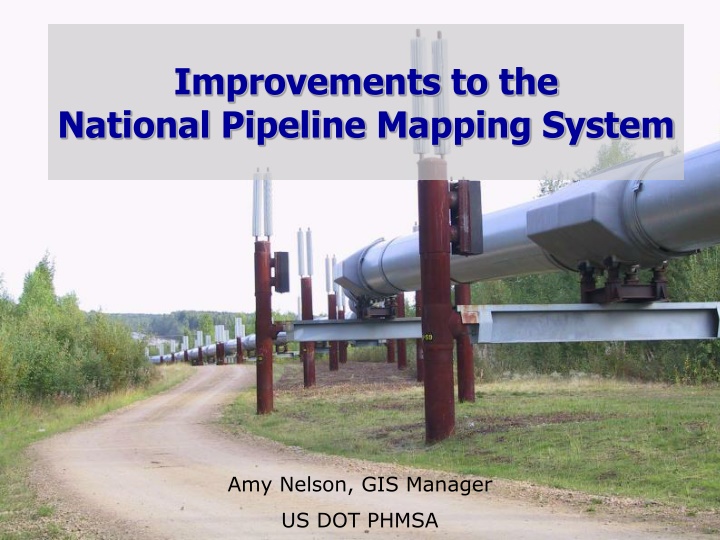
Enhancing National Pipeline Mapping System for Safety and Reliability
The U.S. Department of Transportation's Pipeline and Hazardous Materials Safety Administration is making improvements to the National Pipeline Mapping System (NPMS) to enhance safety, environmental stewardship, and emergency response. Since 1998, the NPMS has been collecting geospatial data from pipeline operators, with upcoming changes including expanding data submissions, tightening positional accuracy, and collecting additional pipeline attributes. These enhancements align with PHMSA's mission to promote awareness of the NPMS and ensure the reliability of pipeline infrastructure.
Download Presentation

Please find below an Image/Link to download the presentation.
The content on the website is provided AS IS for your information and personal use only. It may not be sold, licensed, or shared on other websites without obtaining consent from the author. If you encounter any issues during the download, it is possible that the publisher has removed the file from their server.
You are allowed to download the files provided on this website for personal or commercial use, subject to the condition that they are used lawfully. All files are the property of their respective owners.
The content on the website is provided AS IS for your information and personal use only. It may not be sold, licensed, or shared on other websites without obtaining consent from the author.
E N D
Presentation Transcript
U.S. Department of Transportation Pipeline and Hazardous Materials Safety Administration Improvements to the National Pipeline Mapping System Amy Nelson, GIS Manager US DOT PHMSA
U.S. Department of Transportation Pipeline and Hazardous Materials Safety Administration Introduction: 1998
U.S. Department of Transportation Pipeline and Hazardous Materials Safety Administration What hasn t changed since 1998? The data the NPMS collects.
U.S. Department of Transportation Pipeline and Hazardous Materials Safety Administration 1998: NPMS data standards were written The NPMS (National Pipeline Mapping System) is PHMSA s program of collecting geospatial data from pipeline operators, analyzing the data, and disseminating it 1998 Standards reflected the state of GIS and GPS at the time Optional submissions began in 2000/2001; attributes collected were minimal, to encourage operators to submit Only 6 months for operators to submit after PSIA 2002; PHMSA opted not to change data standards As years go by and technology advances, the deficiencies in PHMSA s dataset become more apparent
U.S. Department of Transportation Pipeline and Hazardous Materials Safety Administration Reauthorization Mandates PHMSA s reauthorization stated: PHMSA must promote greater awareness of the NPMS The Secretary may collect additional geospatial data Result: PHMSA is drafting an Information Collection to obtain the data it needs to perform its mission Will aid mission goals of safety, environmental stewardship, reliability, and assisting emergency responders and government officials
U.S. Department of Transportation Pipeline and Hazardous Materials Safety Administration IC Overview The upcoming Information Collection will expand the data that operators submit to the NPMS and will modify some existing submission elements Positional accuracy will be tightened Additional pipeline attributes will be collected Pipeline-related facility data will be collected LNG plant submissions will have additional attributes Breakout tank submissions will be mandatory
U.S. Department of Transportation Pipeline and Hazardous Materials Safety Administration IC Timeline Federal Register notice will be published in fall 2013 60 day comment period will follow Final notice expected in 2014 Operator submissions of the new data will begin in 2015 at the earliest Security implications of new data will be discussed with TSA; it s unlikely most new data will appear on public portion of NPMS website
U.S. Department of Transportation Pipeline and Hazardous Materials Safety Administration Meeting mission goals The Information Collection will strengthen PHMSA s ability to accurately identify, regulate, and respond to emergencies for pipelines, LNG plants, and breakout tanks PHMSA s ability to evaluate risk for a pipeline will be improved by obtaining basic information about that pipe, such as coating, SMYS, and MAOP Improved positional accuracy will assist emergency responders as well as PHMSA staff and stakeholders in accurately locating the pipe, especially in densely pipelined areas Key PHMSA datasets refer to features not in the GIS; they cannot be analyzed geospatially
U.S. Department of Transportation Pipeline and Hazardous Materials Safety Administration Current 500 foot positional accuracy Dozens of lines are in the 500 foot radius!
U.S. Department of Transportation Pipeline and Hazardous Materials Safety Administration Referencing data the NPMS does not have From PHMSA s Pipeline Datamart Pump/Compressor stations Diameter
U.S. Department of Transportation Pipeline and Hazardous Materials Safety Administration Process of defining data needs Gathered requirements from all levels of PHMSA to understand organizational/mission needs Reviewed currently collected data and identified deficiencies Interviewed five operators about their GIS data; thanks are due to Nisource Marathon National Grid Colonial Access Midstream Spoke with current and former industry employees
U.S. Department of Transportation Pipeline and Hazardous Materials Safety Administration Simplifying Annual Reports Over the past 10 years, PHMSA has made several attempts to replace AR data with NPMS submissions PHMSA does not want to collect duplicate data Our goal: data in the NPMS will replace data currently collected through Annual Reports Should streamline operator s annual report preparation and result in time savings after the initial submission Easier and faster reporting for operators. Better quality and more precise data for all.
U.S. Department of Transportation Pipeline and Hazardous Materials Safety Administration How PHMSA will use the new data Aid government and industry in promoting public awareness of hazardous liquid and gas pipelines and improving emergency responder outreach. Permit more powerful and accurate tabular and geospatial analysis which will strengthen PHMSA s decision support, regulations, and program evaluation. Strengthen the effectiveness of PHMSA s pipeline risk assessment models. Allow for more effective assistance to emergency responders by providing them with a more reliable, complete dataset of pipelines and associated data. Provide better support to PHMSA s inspectors by providing more accurate pipeline locations and additional pipeline-related geospatial data which can be linked to tabular data in PHMSA s inspection database.
U.S. Department of Transportation Pipeline and Hazardous Materials Safety Administration Questions? Amy.Nelson@dot.gov 202-493-0591






















